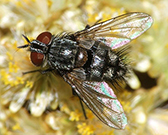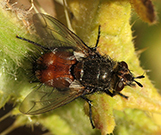home | spring garden | shade garden
Tachinid Fly
Tachinid flies are beneficial insects that help to destroy the threat of harmful insects in a field or garden. There are 8,200 different species of tachinid flies. Each species can vary in color, shape, and size but are known for their bristly look. They typically resemble houseflies. Most tachinid flies are parasitoids. This means their larvae develop inside the harmful insects and kill them. Primary hosts for tachinid flies are caterpillars and beetles. The early life cycle stages of these flies vary from species to species. Some females lay their eggs on foliage near a host insect so that it will continue eating the foliage and also eat the eggs. Some species lay their tiny white eggs on the host, allowing the newly hatched larvae to burrow inside the host's body. A few species have piercing mechanisms that allow for the female to pierce the host insect and deposit her egg directly inside their bodies. In many species of tachinids, eggs can mature inside the female's body so when the egg is laid, it hatches immediately. Some flies even give live birth. The egg and larva stages of the life cycle last from 4 to 14 days. By then, the larva has killed its host and is ready to pupate. This stage takes a couple of weeks. The adult tachinid fly then emerges. Adults may not feed at all. If they do, they will feed on flowers to keep their energy up while they are still able to reproduce.

|

|
